Peter Bihr writes about The Ryanair Test, suggesting that new technology be looked at through an as-if-operated-by-Ryanair lens:
What would this look like in real life if it was operated by Ryanair? Would it still be cool, or totally suck? Where would all the up-sell happen? How would it be to be blasted with ads while using it?
A similarly helpful test, when we’re formulating public policy, might be to stop to consider how whatever program or service we’re calling for will look like when operated by government.
Not by an idealized utopian government, but by the actual always-partly-broken, powered-by-fallible humans government.
Too often we make the mistake of coming up with plans that assume they’ll be implemented by caring, future-thinking people, skilled in systems thinking, and with the agency to evolve plans as they go. This is almost never the case.
Scrolling through the updated Photos app on my newly-updated-to-Catalina Mac, I came across thumbnails of the sketches I’d posted here earlier. They have a completely different quality once shrunk down like this, and you can almost imagine them being panels in a wordless comic that involves Rob MacDonald, Cherry Valley and the East Point lighthouse.
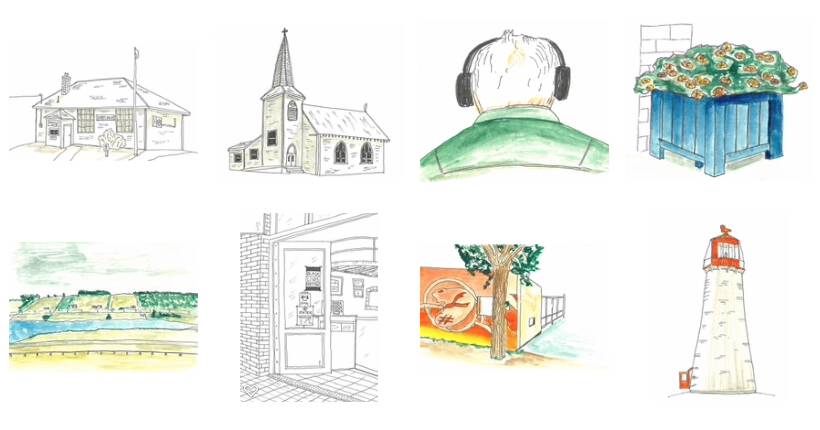
Something to note about our new refrigerator: unlike every other refrigerator I’ve ever purchased, it came without “butter compartment” in the fridge section and without ice cube trays (and a shelf for them) in the freezer section.
I wonder how these features got designed out: there’s an interesting home economics story to be told there, I’m sure.
We compensated for the lack of ice cube making capability by purchasing a Good Grips No-Spill ice cube tray; for butter storage, we opted to handle this on the outside, and are now proud owners of a Village Pottery French butter keeper, inspired by purchase of same by our forerunning friend Jonas on a visit two years ago.
Around about 6:30 a.m. this morning, with just the earlymost stirrings of the day started to make themselves known, I rolled my head in a way that seemed unremarkable as I was doing it. Until it didn’t feel unremarkable at all, and instead felt like I was on a roiling ocean liner amidst a hurricane: the room was spinning, and I was, it became clear, a victim of “sudden onset vertigo”–BPPV.
I’ve been fooling around the vertigo for some years now (here, here) and I’ve come to classify it into two types: there’s the background feeling of being slightly out of sorts that I’ve lived with unceasingly for a couple of years that appears to be related to the tendency of my eyes to not track properly, and there’s the tsunami-like vertigo I experienced this morning.
Fortunately, because of my longstanding dalliance, I had the steps of the Epley Manoeuvre (mostly) memorized, and was able to deploy it quickly. The positive effects were almost immediate, leaving me feeling less like on a roiling ocean liner amidst a hurricane and more like on a roiling canoe on a choppy day.
Unable to face the notion of sitting in front of a screen for the morning, I called in sick, arranged the pillows on the bed for best anti-dizzying effect, and spent the morning motionless. It helped.
Oliver, bless his heart, brought me lunch in bed. I resisted all urges toward productivity (so what if the office humidity skyrockets to 75% because I don’t empty the dehumidifier: the basement will survive). It was a wise move, as I felt better and better as the day progressed, and, as I write, I feel more hungover than roiling.
Thank you, Dr. John Epley, for your crafty manoeuvre.
The Festival of Maintenance finds itself in need of maintenance:
We’re now looking to hire a designer who can help us with a rebrand and get people as fired about maintenance as we are.
We’re looking for someone who can help us communicate some tricky concepts — care, repair, shared (and often hidden) labour — through a cleaner, more recognisable brand.
The festival is once of those things that comes along, rarely, that hits almost every single one of my buttons.
We members of the 100 Prince Street household were saddened when the 2020 edition of Island Fringe was understandably cancelled due COVID, and delighted to learn of an Island Fringe side hustle, Pounding the Pavement, that was launched in cooperation with Confederation Centre of the Arts:
Island artists who identify as Indigenous, BIPOC, 2SLGBTQ+, and those with a disability come together to tell their own stories from their own perspectives. Performances are made up of 10-20 minute vignettes that explore people’s journeys of discovery to having their voices heard (be they personal explorations, activism for equality, etc), and presented as dramatic readings of original poetry and plays, songs, dance, and stand-up comedy.
With performances by Claire Byrne, Homemaker, Jay Gallant, Joce Reyome, Julie Bull, Reequal Smith, Sadie McCarney, Tanya Nicolle, and more, audiences will be moved by this experience.
Oliver and I went last night, and it was everything promised. Highly recommended.
Pounding the Pavement runs again tonight and tomorrow night, and you can buy tickets through the Confederation Centre box office. As there’s a chance you’ll be sitting on the concrete steps of the Confederation Centre’s amphitheatre, bringing a cushion is suggested; as it’s two hours long with no intermission, bringing a water is suggested too. The social distancing seating setup is top-flight: ushers were masked, seating spaced laudably distant; I felt in no imminent danger.
My company, Reinvented Inc., is an Island Fringe sponsor.
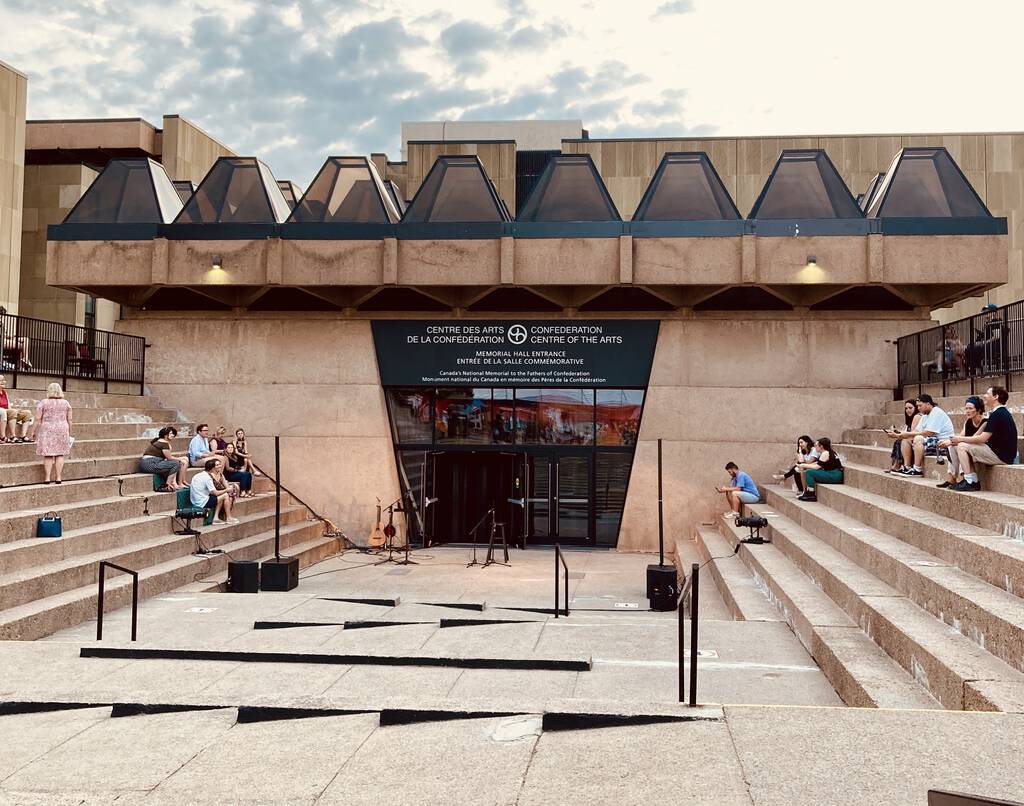
Island Nature Trust is again organizing a walk, at low tide, to St. Peter’s Island.
I absolutely loved doing this walk last year: if you’ve never done it, I highly recommend it.
Act quickly: only 30 spots, and they fill quickly.
A friend, let’s call him “Bob Gray,” asked for advice on the best way to cycle from UPEI across town to Riverside Drive. I gave him my suggested route:
- Go down the trail from UPEI to the Experimental Farm road (by the beehives).
- Turn left, uphill, through the farm building complex to Crop Lane, which will lead you to Mt. Edward Road.
- Cross Mt. Edward Road to Confederation Street, past Parkdale Elementary School. Cross St. Peter’s Road and continue along St. Plus X to Kensington Road.
- Take a left then a right onto Garfield Street, which will lead you straight to the Riverside Drive trail.
On Saturday, after cycling out to Gallant’s for our smoked salmon bagels, and back to the Charlottetown Farmers’ Market for our weekly shop, our next stop was Riverview Country Market, and I resolved that we should subject ourselves to The Bob Gray Way to see whether it actually works.
Here’s the map of our complete 15 km Saturday cycle:
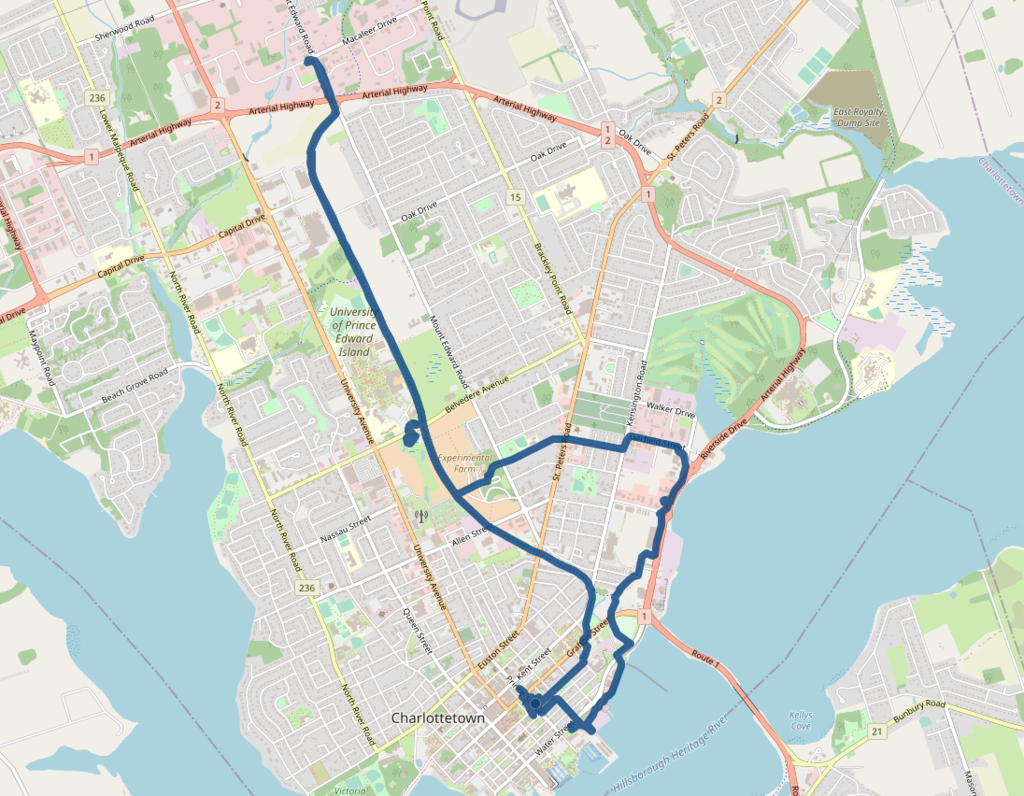
Here’s The Bob Gray Way:
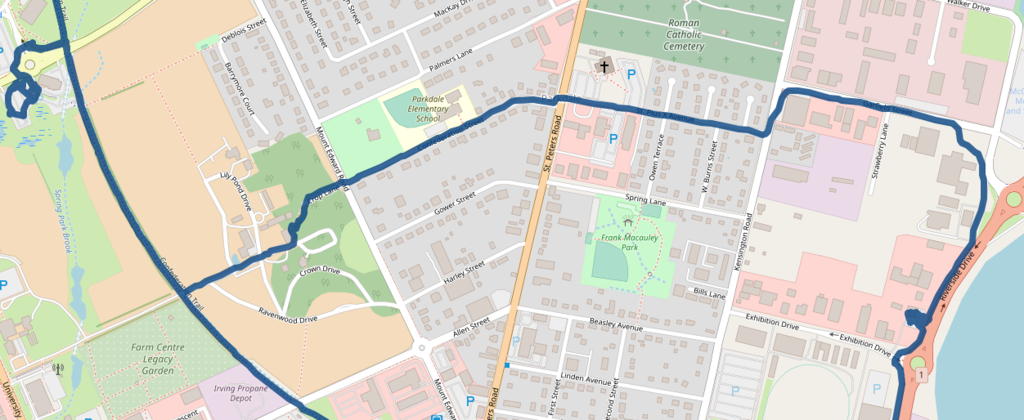
We discovered some pitfalls:
- Crop Lane is almost impossible to find: it runs in from Mount Edward Road to the Experimental Farm, but in a non-obvious way that doesn’t connect to any of the other farm roads. You can cycle to it by going in back of a large farm building and going along a rough dirt trail.
- Garfield Street is rocky and sandy, has no shoulder, and vehicles don’t expect to find bicycles there, so it didn’t feel safe to cycle on. As you can see from our route on the map, we departed Garfield and cut through the Liquor Commission and Access PEI parking lots to avoid some of this.
- The Riverside Drive multi-use trail, which is a great gift to cyclists, is, nonetheless, somewhat harrowing to cycle: while it is physically separated from the roadway, when there’s a large transport truck using its air brakes a couple of metres away from you that physical separation doesn’t feel very comfortable.
On the upside, we avoided the Allen Street roundabout, the tricky Allen Street-St. Peters Road intersection, and Exhibition Drive.
But we had confirmed for us that east-west cycling in Charlottetown remains no easy feat.
As the area north of Exhibition Drive shifts quickly from industrial to residential, we should start thinking more about what the active transportation routes in and out of this area should be, and especially what the best way to safely connect to the Confederation Trail spine is.
I have a passing interest in O’Keefes Lake, a freshwater lake in Queens County, Prince Edward Island, near Avondale. If you’ve ever headed out the 48 Road from Charlottetown to Cardigan, you’ve passed it, perhaps without even knowing so, as it’s well-hidden from the road by trees: there’s just a short piece of road where you can look to the left to see the lake.
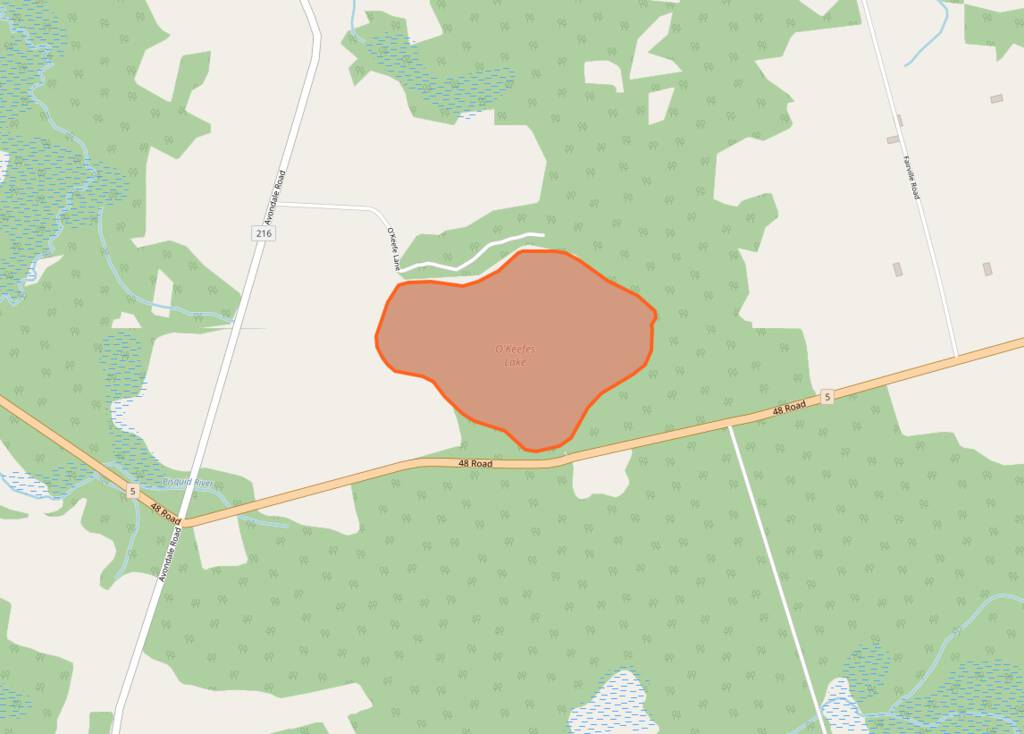
My interest in the lake was spurred some years ago when a substantial portion of its shoreline and, if memory serves, about half the lake itself, was for sale at a price that seemed remarkably low given, well, that you got to own half a lake.
Ultimately we found ourselves not in need of half a lake, perhaps put off, as well, by reports that the mercury levels in fish from the lake “can be in excess of recommended guidelines.” Who wants to own half a mercury-poisoned lake?
Of late, though, my interest in O’Keefes Lake extends to the mysterious presence of O’Keefe Lake Provincial Park on Google Maps:
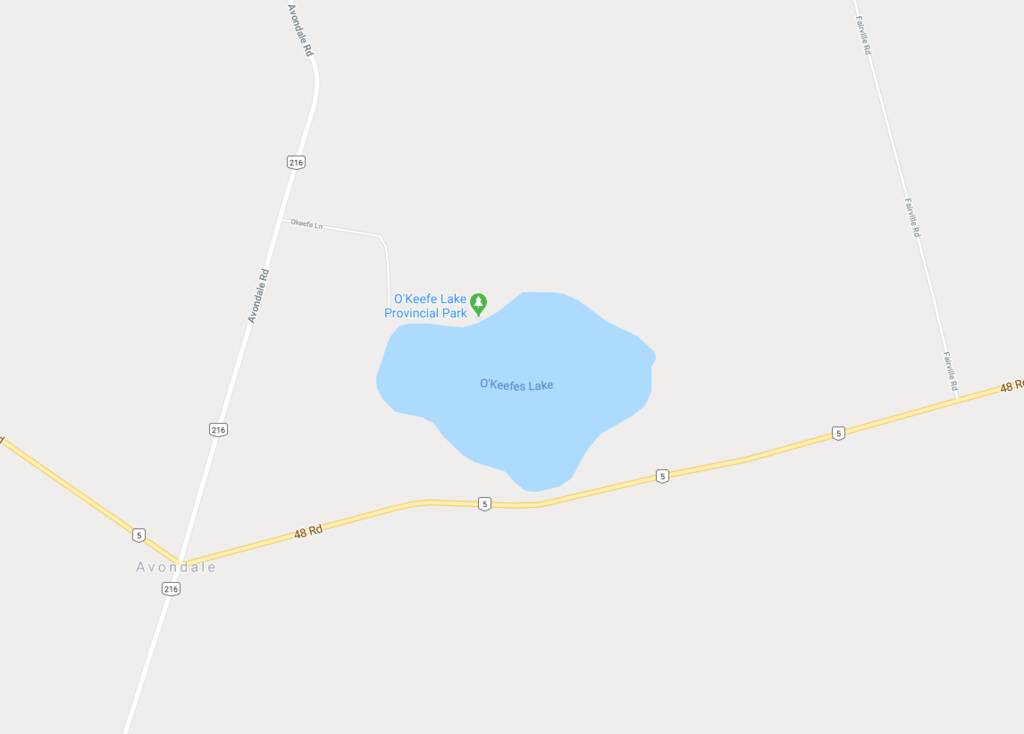
It’s there on Apple Maps too, if you search:
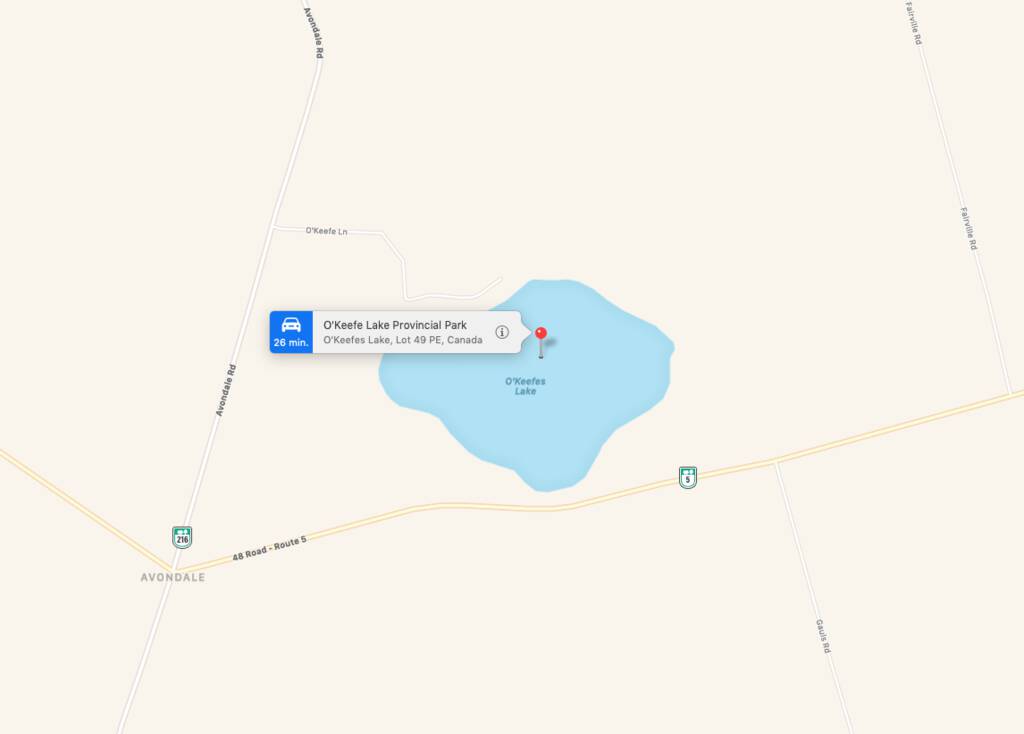
This is mysterious because there is, and never has been, an O’Keefe Lake Provincial Park.
It doesn’t exist.
And yet it’s on the map!
My assumption is that it’s on the map because, at one point, it was approved as an official Geographic Name, and appears in the Canadian Geographic Names Database, albeit, now, with the status of “Previously Official.”
I’m presuming that, at some point in the past, Google and Apple, or their upstream geodata providers, hoovered up all of the geographic names of the world, including those from Canada, and haven’t updated since O’Keefe Lake Provincial Park stopped being a geographic name. I’m presuming this because I did exactly this myself many years ago.
A side-effect of the non-existent O’Keefe Lake Provincial Park being viewed as an official geographic name is that several websites that use geographic place names as their basis for providing information have also hoovered up the name, and so you can, among other things, get the weather for O’Keefe Lake Provincial Park:
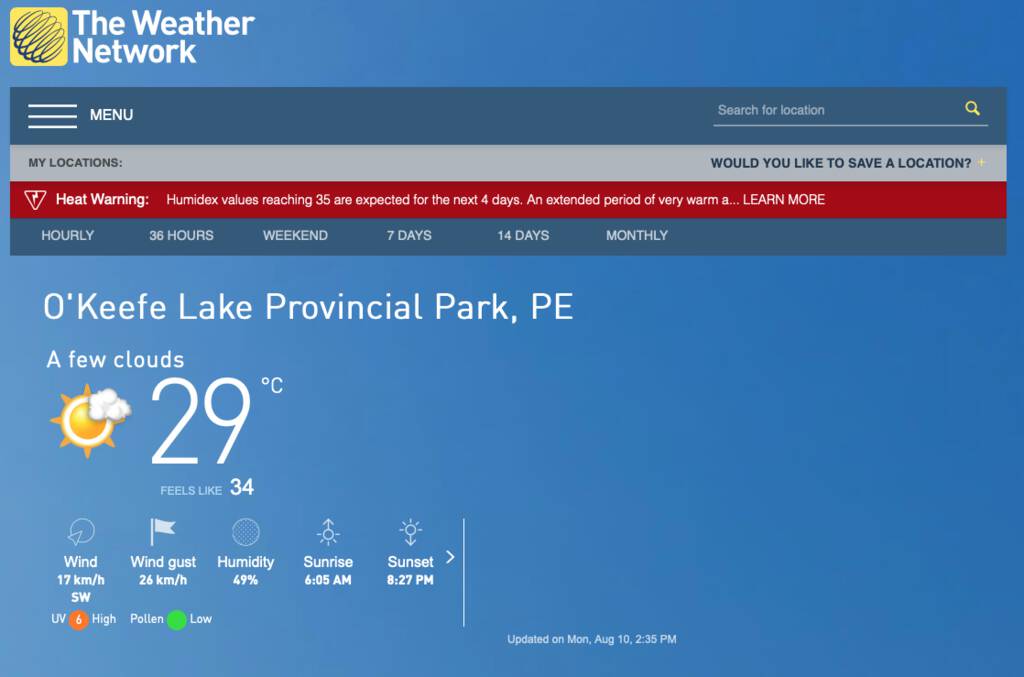
You can read about the “park” in Wikipedia in Swedish:

And you can book a table at one of the 11 nearby restaurants:
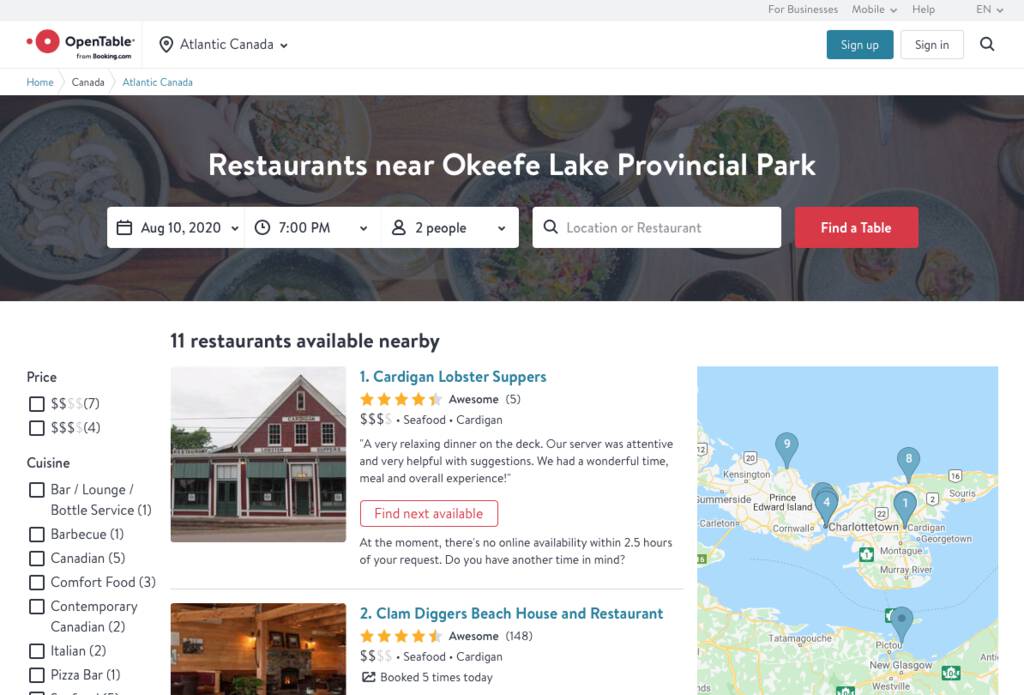
You may have noticed that it’s O’Keefe Lake Provincial Park, but O’Keefes Lake, with an “s.” It seems that the geographic name for the lake was originally approved, in 1946, as O’Keefe Lake and then, in 1966, changed to O’Keefes Lake.
All of which has me wondering:
- Who was the O’Keefe (or who were the O’Keefes) after which the lake is named?
- Why was the name changed?
- Why was a geographic name for a Provincial Park approved, but the park never created?
- Why is there mercury in the fish in O’Keefes Lake?
My next task is to try to make O’Keefe Lake Provincial Park disappear from the Internet: I’ve submitted edit requests to Google Maps and Apple Maps, I’ll add a note to the Swedish Wikipedia page, suggested the province update its PlaceFinder, and I’ll continue to monitor the situation until the vestiges of the park confuse us no more.
A trio of contrarian viewpoints caught my attention over the last month:
- Oatly: The New Coke (via Hacker News)
- Small Family Farms Aren’t the Answer (via Citizens Alliance of PEI newsletter)
- Small Businesses Are Overrated (via Lou Eastman on Facebook)
In each case, the authors take something that, at least in progressive circles, is taken as motherhood gospel–oat milk, small family farms, small business–and suggests that not everything is as it seems.
Contrarian dissonance is important; it’s so easy to get trapped inside an echo chamber where certain truths are forever declared self-evident.
I thought of this when I was sent links to to petitions regarding the proposed development of a 99-unit apartment complex on the Charlottetown waterfront.
Both petitions mention the character of the neighbourhood as a reason for opposing the project.
Preserving Our Waterfront calls out the “heritage view”:
The proposed concrete and steel structure is not compatible with lower Water Street and the surrounding area. The heritage view was not considered!
While Charlottetown City Council: Deny a Building Permit for 8 story waterfront development mentions the “aesthetic of this quiet, residential neighbourhood”:
If this development is allowed to go ahead, it will change the aesthetic of this quiet, residential neighbourhood. The scale of it will overwhelm the existing surrounding buildings, many of them Heritage properties.
There may be other perfectly valid reasons for opposing this project, and both petitions contain bullet points of them, but if we’re going to increase urban density in Charlottetown, we need to get ourselves to realize that this will mean the scale, shape, and character of the city has to change. No, we shouldn’t have torn down Penn Station, but that doesn’t mean that nothing should ever change. And it means that “quiet residential neighbourhoods” and “heritage views” may need to be reconsidered.
Increased urban density is the clear ecological path forward for its decreased commutes, decreased need for parking, decreased urban sprawl, increased efficiency of public and commercial services. It makes sense to pack more of us together in closer proximity in more energy efficient ways.
I don’t know whether the building that’s the subject of these petitions should go forward, and my knee-jerk reaction, given my antipathy toward the developer, was to oppose it.
But, like a love of oat milk and deification of small businesses and small family farms, perhaps we need to give our assumptions a check from time to time, and realize that progressive change comes in all sorts of packages, and sometimes a knee-jerk reaction is a signal to stop and take a second look.
 I am
I am